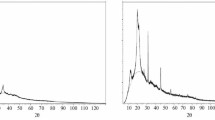Summary
Using cellulose as the layer, the thin-layer chromatographic behaviour of metals of the major groups I, II, IV, V and VI in solvent mixtures of halogen acids (HF, HCl, HBr, HI) and alcohols (methanol, ethanol, propanol-(1), butanol-(1)) is described. The results are compiled in RF spectra. It is attempted to interpret the transport mechanisms, considering the chromatographic process as a distribution between stationary and mobile phase. So as to identify the form in which the metal is present during development — cation, non-dissociated molecule, or halogen complex —, ion exchange and extraction were used for comparison purposes. Separation possibilities for the individual ions are indicated. In an earlier publication (1) we discussed the behaviour of the major group III in the system halogen acid —alcohol. The problems encountered at that time made it appear interesting to investigate the behaviour of the remaining metals. The present paper presents a comprehensive investigation with regard to the metals of the main groups, with particular emphasis on the separation possibilities and transport mechanisms.
Zusammenfassung
Auf Cellulose als Schicht wird das dünnschichtchromatographische Verhalten der Metalle der I., II., IV., V. und VI. Hauptgruppe in Laufmittelgemischen aus Halogenwasserstoffsäuren (HF, HCl, HBr, HJ) und Alkoholen (Methanol, Äthanol, Propanol-(1), Butanol-(1)) beschrieben. Die Ergebnisse werden in RF-Spektren zusammengefaßt. Es wird versucht, die Transportmechanismen zu interpretieren, wobei der Chromatographiervorgang als Verteilung zwischen stationärer und mobiler Phase aufgefaßt wird. Zur Identifizierung der während der Entwicklung vorliegenden Form des Metalls — Kation, undissoziiertes Molekül oder Halogenokomplex — werden Ionenaustausch und Extraktion zum Vergleich herangezogen. Trennmöglichkeiten für die einzelnen Ionen werden angegeben.
In einer früheren Publikation [1] diskutierten wir das Verhalten der III. Hauptgruppe im System Halogenwasserstoffsäure —Alkohol. Die dabei aufgeworfenen Probleme ließen es von Interesse erscheinen, auch das Verhalten der übrigen Metalle zu untersuchen. In vorliegender Arbeit wird eine zusammenfassende Untersuchung bezüglich der Hauptgruppenmetalle durchgeführt, wobei Trennmöglichkeiten und Transportmechanismen besondere Beachtung finden.
Sommaire
Le comportement en chromatographique sur couche mince de poudre de cellulose des métaux des groupes I, II, IV, V et VI dans le cas des mélanges solvants formés d'hydracides (HF, HCl, HBr, HI) et d'alcools (méthanol, éthanol, propanol-(1), butanol-(1)) est décrit. Les résultats sont groupés dans les tableaux de Rf. On essaie d'interpréter les mécanismes de transport, en considerant le processus chromatographique comme une distribution entre les phases fixe et mobile. Afin d'identifier la forme sous laquelle le mètal est présent pendant le développement — cation, molécule non-dissociée, ou complexe halogéné —, l'échange d'ions et l'extraction sont employées en vue de comparaisons. Des possibilités de séparation pour les ions individuels sont indiquées.
Dans une publication antérieure (1) nous avons discuté du comportement des métaux du groupe III dans le système solvant hydracide-alcool. Les problèmes qui ont été alors posés ont permis de mettre en évidence l'intérêt qui'il y aurait à examiner également le comportement des autres métaux. Le présent travail constitue une étude d'ensemble pour les métaux des divers groupes, et met l'accent sur les possibilités de séparation et sur les mécanismes de transport.
Similar content being viewed by others
Literatur
Gagliardi, E. undBrodar, B.: Chromatographia2, 267 (1969).
Seiler, H. undRothweiler, W.: Helv. chim. Acta44, 941 (1961).
Druding, L. F.: Anal. Chem.35, 1582 (1963).
Lesigang, M.: Mikrochim. Acta34, (1964).
Kawamara, S.: et al., J. Chromatog.26, 557 (1967).
Rudolff, H.: Dtsch. Apothekerzeitg.102, 1571 (1962).
Hartkamp, H. undSpecker, H.: Z. analyt. Chem.152, 107 (1956).
Gagliardi, E. undLikussar, W.: Mikrochim. Acta699 (1965).
Kraus, K. A. undNelson, F.: Peaceful Uses of Atomic Energy Conference, Geneva, Vol.VII, p. 113 (1955).
Cotton, F. A. undWilkinson, G.: Anorganische Chemie, Verlag Chemie, Weinheim 1967.
Dean P. A. W. undEvans, D. F.: Proc. Chem. Soc. (London)407 (1964).
Ragsdale, R. O. undStewart, B. B.: Inorg. Chem.4, 740 (1965).
Bottari, E. undCiavatta, L.: J. Inorg. Nucl. Chem.27, 133 (1965).
Kitahara, S.: Bull. Inst. physic. chem. Res. (Tokyo)24, 454 (1948); ref. inKoch, O. G. undKoch-Dedic, G. A., Handbuch der Spurenanalyse, Springer Verlag 1964.
Bock, R. undHerrmann, M.: Z. anorg. allgem. Chem.284, 288 (1956); ref. inKoch, O. G. undKoch-Dedic, G. A., Handbuch der Spurenanalyse, Springer Verlag 1964.
Rai, J. undKukreja, V. P.: Chromatographia2, 18 (1969).
Author information
Authors and Affiliations
Additional information
Auszug aus der Dissertation vonB. Brodar, Universität Graz 1969
Rights and permissions
About this article
Cite this article
Galiardi, E., Brodar, B. Dünnschicht-Chromatographie von Metallen auf Cellulose. II Verhalten der I., II., IV., V. und VI. Hauptgruppe im System Halogenwasserstoffsäure—Alkohol. Chromatographia 3, 7–12 (1970). https://doi.org/10.1007/BF02276394
Received:
Accepted:
Issue Date:
DOI: https://doi.org/10.1007/BF02276394




